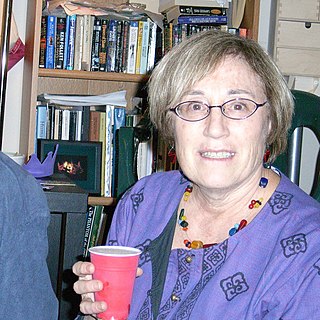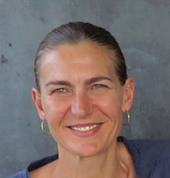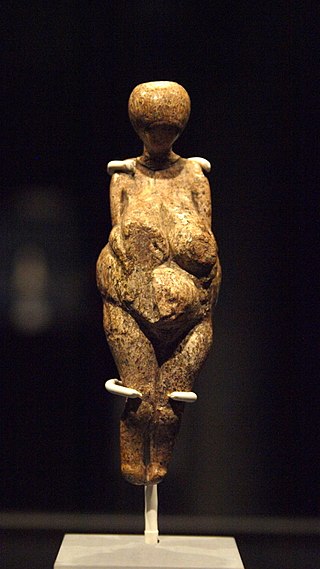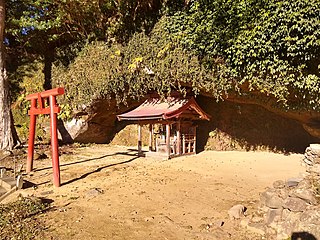Related Research Articles
Osteology is the scientific study of bones, practised by osteologists. A subdiscipline of anatomy, anthropology, and paleontology, osteology is the detailed study of the structure of bones, skeletal elements, teeth, microbone morphology, function, disease, pathology, the process of ossification, and the resistance and hardness of bones (biophysics).

Dorothy Annie Elizabeth Garrod, CBE, FBA was an English archaeologist who specialised in the Palaeolithic period. She held the position of Disney Professor of Archaeology at the University of Cambridge from 1939 to 1952, and was the first woman to hold a chair at either Oxford or Cambridge.

Bruce Graham Trigger was a Canadian archaeologist, anthropologist, and ethnohistorian. He was appointed the James McGill Professor at McGill University in 2001.
Govardhan Rai Sharma (1919-1986) was a Historian from Allahabad University who led the Kausambi excavations which added to original historical research in the country. The ruins of this ancient city were found on the left bank of the river Yamuna, 70 km south-west from Allahabad. Thus commenced excavations of the site by the late Prof. G.R. Sharma of the Allahabad University in 1949 and again in 1951-1956. Following these excavations numerous remains of the ancient city came to light. He is among the historians who brought archeology in the mainstream of studying History.
Robert Bradford Fox (1918–1985) was an anthropologist and leading historian on pre-Hispanic Philippines.

The Joukowsky Institute for Archaeology and the Ancient World is an interdisciplinary center at Brown University focused on research and teaching of archaeology, with an emphasis on the archaeology and art of the ancient Mediterranean, Egypt, and the Near East. Brown's undergraduate and graduate programs in archeology are organized through the institute.

Mugharet el-Zuttiyeh is a prehistoric archaeological site in Upper Galilee, Israel. It is situated 800 m (2,600 ft) from the Nahal Amud outlet, approximately 30 m (98 ft) above the wadi bed. It was found to house a fossil today known as the "Galilee skull" or "The Yabrudian Man".

Pakistan is home to many archaeological sites dating from Lower Paleolithic period to Mughal empire. The earliest known archaeological findings belong to the Soanian culture from the Soan Valley, near modern-day Islamabad. Soan Valley culture is considered as the best known Palaeolithic culture of Central Asia. Mehrgarh in Balochistan is one of the most important Neolithic sites dating from 7000 BCE to 2000 BCE. The Mehrgarh culture was amongst the first culture in the world to establish agriculture and livestock and live in villages. Mehrgarh civilization lasted for 5000 years till 2000 BCE after which people migrated to other areas, possibly Harappa and Mohenjo-daro. Harappa and Mohenjo-daro are the best known sites from the Indus Valley civilization.
Sally Binford was an archaeologist and feminist. A prehistorian, she contributed alongside her husband to the formation of processual archaeology.
Ethnomuseology is the study of museums and museum curation in the context of the culture and cultural traditions of its collections. It is an interdisciplinary field combining museum studies, anthropology, ethnography, and often various fine arts.

The El Mirón Cave is a large cave in the upper Asón River valley towards the eastern end of Cantabria in northern Spain, near the border of the Basque Country. It is an archeological site in Ramales de la Victoria. It is known for a skeleton belonging to a woman nicknamed The Red Lady of El Mirón. She is estimated to have died around 18,700 years ago, during the Upper Paleolithic (Magdalenian). The skeleton is estimated to be that of someone between 35 and 40 years. Her bones were coated with ochre, a red iron-based pigment, hence, her name.
H. Martin Wobst is an American anthropologist who was at University of Massachusetts and an Elected Fellow of American Association for the Advancement of Science, Royal Anthropological Institute and Society for American Anthropology.

Joan Margaret Gero was an American archaeologist and pioneer of feminist archaeology. Her research focused on gender and power issues in prehistory, particularly in the Andean regions of Argentina and Peru.

Lucinda Backwell is an archaeologist and a member of the Academy of Science of South Africa. She obtained her MSc in palaeoanthropology from the University of the Witwatersrand Medical School in 2000. Her PhD in palaeoanthropology was awarded in 2004, making her the first South African woman to be awarded a PhD in palaeoanthropology at a local institution.

Andrée Jeanne Rosenfeld FAHA (1934-2008) was an archaeologist specialising in rock art.

The Venus figurines of Kostenki are prehistoric representations of the female body, usually in ivory and usually dated to between 25,000 and 20,000 years ago, making them part of the Gravettian industry of the Upper Palaeolithic period. Found in the Kostyonki-Borshchyovo archeological complex in Russia, these Venus figurines are now in the Hermitage Museum.
Lynn Meskell is an archaeologist and anthropologist who currently works as a Professor at the University of Pennsylvania.
Koji Mizoguchi is a Japanese archaeologist and a professor of social archaeology in the Graduate School of Social and Cultural Studies at Kyushu University. He studies the comparative emergence of societies in Europe and Japan and has a particular interest in the history of archaeology. He currently serving as the sixth president of the World Archaeological Congress, serves as director of the Advanced Asian Archaeology Research Center at Kyushu University, and is an elected fellow of the London Society of Antiquaries. He has been involved in numerous archaeological projects, and is currently a co-director of the project ‘Beneath Hay Bluff: prehistoric south-west Herefordshire, c.4000-1500 BC.'

Fukui Cave is a significant paleolithic site located in Fukui, Yoshii-cho near Sasebo, Japan from the early incipient Jōmon period. Humans have been occupying the site since at least 30,000 years ago Pottery discovered at this site dates back to around 12,700 years ago and are among the oldest found in the world. The steep cliffs of the cave are made of sandstone, and in the surrounding area is found volcanic basalt from the late Miocene era. Landslides over the years have changed the flow of the Fukui river, forming the present shape of the caves. During lithic times, the cave was surrounded by temperate forests with ample amounts of chestnuts, walnuts and acorns.
References
- 1 2 3 4 5 6 Tomii, M (2014). "Ikawa-Smith, Fumiko". Encyclopedia of Global Archaeology (2014 ed.). New York, NY: Springer. pp. 3686–3688. doi:10.1007/978-1-4419-0465-2_2458. ISBN 978-1-4419-0465-2.
- 1 2 Colson, Alicia. "Fumiko Ikawa-Smith: Her Own Kind of Woman". Trowelblazers. Trowelblazers. Retrieved 5 April 2020.
- ↑ "Emeritus and Retired Faculty, Department of Anthropology, McGill University". Department of Anthropology, McGill University. McGill University. Retrieved 6 April 2020.
- ↑ Ainley, Marianne Gosztonyi (2012). Creating Complicated Lives: Women and Science at English-Canadian Universities, 1880-1980. Montreal and Kingston: McGill-Queens University Press. p. 159. ISBN 978-0-7735-8795-3.
- ↑ "JSAC President (2004-07)" (PDF). JASC. York University. Retrieved 5 April 2020.
- ↑ "People / People / Emeritus and Retired Faculty, Department of Anthropology, McGill University". Department of Anthropology. McGill University. Retrieved 6 April 2020.
- ↑ "Fumiko Ikawa-Smith Professor Emerita". McGill Anthropology. McGill University. Retrieved 6 April 2020.
- ↑ "Entry for Philip E. L. Smith". Library of Congress Database. Library of Congress. Retrieved 6 April 2020.
- 1 2 Tomii, M (2014). "Ikawa-Smith, Fumiko". Encyclopedia of Global Archaeology (2014 ed.). New York, NY: Springer. pp. 3686–3688. doi:10.1007/978-1-4419-0465-2_2458. ISBN 978-1-4419-0465-2.
- 1 2 3 4 5 6 7 8 9 Tomii, M (2014). "Ikawa-Smith, Fumiko". Encyclopedia of Global Archaeology (2014 ed.). New York, NY: Springer. pp. 3686–3688. doi:10.1007/978-1-4419-0465-2_2458. ISBN 978-1-4419-0465-2.
- ↑ Ainley, Marianne Gosztonyi (2012). Creating Complicated Lives: Women and Science at English-Canadian Universities, 1880-1980. Montreal and Kingston: McGill-Queens University Press. p. 159. ISBN 978-0-7735-8795-3.
- ↑ Ainley, Marianne Gosztonyi (2012). Creating Complicated Lives: Women and Science at English-Canadian Universities, 1880-1980. Montreal and Kingston: McGill-Queens University Press. p. 159. ISBN 978-0-7735-8795-3.
- ↑ Colson, Alicia. "Fumiko Ikawa-Smith: Her Own Kind of Woman". Trowelblazers website. Trowelblazers. Retrieved 6 April 2020.
- ↑ N/A. "Author: Philip E.L. Smith". Author, Sites, Expedition, Penn Museum. Penn Museum. Retrieved 6 April 2020.
- ↑ "Author: Philip E.L. Smith". Penn Museum. Penn Museum. Retrieved 6 April 2020.
- ↑ Grzymski, K. (January 1, 2001). Canadian Expedition to Nubia I: Hambukol Excavations 1986-1989 (SSEA Publication (Book 16) ed.). Benben Publications. p. 219. ISBN 9780920168165.
- 1 2 3 4 5 6 7 8 9 10 11 Colson, Alicia. "Fumiko Ikawa-Smith: Her Own Kind of Woman". Trowelblazers. Trowelblazers. Retrieved 6 April 2020.
- ↑ Colson, Alicia. "Fumiko Ikawa-Smith: Her Own Kind of Woman". Trowelblazers. Trowelblazers website. Retrieved 6 April 2020.
- ↑ "home page of the Japan Studies Association of Canada. JSAC began as JSSAC (Japan Social Sciences Association of Canada" (PDF). Japan Studies Association of Canada. Japan Studies Association of Canada. Retrieved 6 April 2020.
- 1 2 3 Colson, Alicia. "Fumiko Ikawa-Smith Her Own Kind of Woman". Trowelblazers. Trowelblazers. Retrieved 6 April 2020.
- ↑ Colson, Alicia. "Fumiko Ikawa-Smith: Her Own Kind of Woman". Trowelblazers. TrowelBlazers website. Retrieved 1 April 2020.
- 1 2 Colson, Alicia. "Fumiko Ikawa-Smith: Her Own Kind of Woman". Trowelblazers Website. Trowelblazers. Retrieved 2020-03-27.
- ↑ "Centre for East Asian Studies". McGill University. McGill University. Retrieved 6 April 2020.
- ↑ "Centre for East Asian Studies". Centre for East Asian Studies, McGill University. McGill University. Retrieved 6 April 2020.
- ↑ "Fumiko Ikawa-Smith's page". ResearchGate. Retrieved 5 April 2020.
- ↑ "JSAC President (2004-07)" (PDF). JASC. York University. Retrieved 5 April 2020.
- ↑ "Japan Studies Association of Canada / Association canadienne d'études sur le Japon". York University. Retrieved 26 March 2020.